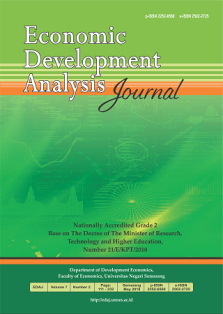Village Fund Transfer and Rural Poverty in Indonesia
Abstract
The model of government policy has been somewhat over-oriented to the efficiency (development); this is especially in the urban areas. As a result, rural areas are left behind and the urbanization rates are continuously growing since the life supports in a city are more varied rather than the homogenous supports in a village. This results in inequality and the poverty within the village. To resolve this problem, the government has constituted the Regulation No. 6 of 2014 Considering Rural Areas in advancing the development of rural areas. The objective of this present study is to find out the effectiveness of the transfer of village funds in solving the issue of poverty in all villages within all the provinces in Indonesia during the period of the implementation of the program. Furthermore, this research was conducted by using econometric method through the equation of panel data in 2015 to 2016 in 33 provinces. The result reveals that the transfer of village funds is not significant in alleviating the issue of poverty in rural areas. By that, it is recommended to increase the amount of the fund of the program to reduce the rate of poverty in all villages in Indonesia.


